Vintage Treasures: A Touch of Strange by Theodore Sturgeon
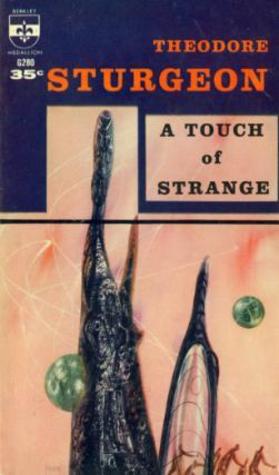 |
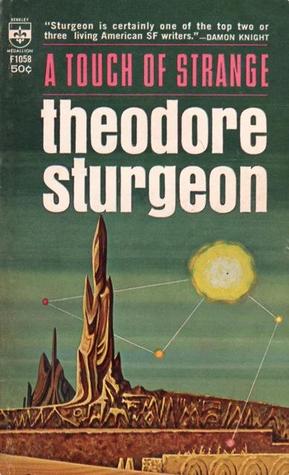 |
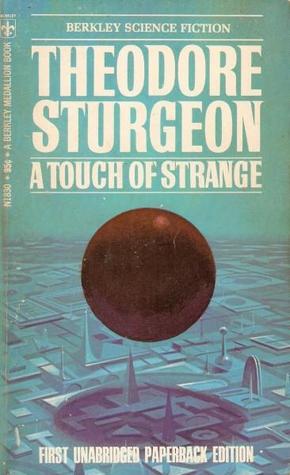 |
I’ve really been enjoying this gradual survey I’ve been doing of Theodore Sturgeon’s paperbacks. It hasn’t been a particularly deliberate undertaking… the truth is that, as I come across his books, I’ve been talking about them. This week I stumbled on a copy of the 1965 Berkley edition of A Touch of Strange (above middle), and here we are.
Part of the reason I enjoy them is that I find it fascinating that a writer could have made a decent living in this business selling almost exclusively short stories. Sturgeon did write five novels (six, if you want to count his 1961 Voyage to the Bottom of the Sea novelization), but he’s far more well known for more than two dozen short fiction collections. And it was upon them that he largely built his considerable reputation.
Another reason is that I genuinely find it delightful to catalog the different editions, and note all the variations. A Touch of Strange was reprinted five times, by three different publishers, between 1958 and 1978, before it vanished from bookstores forever. Each of those editions is unique, not just in cover art and design, but also in how it was packaged and presented — and, in some cases, in content as well.
[Click on the images for bigger versions.]
Now, it’s hardly a surprise that publicists and marketing folks find different ways to sell books as decades go by. Sometimes those changes are subtle, and sometimes, not so much. For an extreme example of how the marketing of a book can radically change over the years, have a look at the drastically different covers for Fritz Leiber’s famous horror novel in Lust, Women, and the Devil: Seven Decades of Fritz Leiber’s Conjure Wife.
The changes for Theodore Sturgeon’s A Touch of Strange are more subtle, but just as interesting. It was his seventh short story collection, and first released in hardcover in July 1958, and in an abridged paperback edition from Berkely in October that same year, with a Richard Powers cover (above left). The message with this edition is simple, and generally in keeping with SF marketing of the 1950s: it’s all about the strangeness and endless possibilities of outer space.
Here’s the back cover copy:
Theodore Sturgeon is one of America’s most gifted science fiction writers. This fine collection is a magnificent example of the author’s ingenuity and skill.
Whether he is ranging the stars of outer galaxies or exploring the deeps of the far distant future, Mr. Sturgeon never loses touch with the people who are involved in his tales. His imaginative and fanciful excursions into time and space are all deeply rooted in reality — in the fascinating variety of human fears and emotions which strange circumstances can produce.
“Theodore Sturgeon is one of the better craftsmen exploring the strange byways of other worlds… highly recommended to those who like their reading offbeat.”
— Cape Cod Standard-Times
Yes, there’s a nod to Sturgeon’s gift for character studies, but the emphasis is still on “ranging the stars of outer galaxies” and “exploring the strange byways of other worlds.” That what you shelled out your hard-earned 35 cents for in 1958, and you expected to get it.
Fast forward to 1965. The new Berkley paperback edition has a fresh cover, courtesy of artist Mike Trent, that’s just as abstract as the Powers, in a space-sure-is-strange kind of way. But there’s a subtle shift in the marketing text on the back:
Theodore Sturgeon
Theodore Sturgeon is one of America’s most versatile science fiction writers. Any list of the top ten in modern American science fiction is bound to include his name.
Whether he is ranging the stars of the outer galaxies or exploring the depths of the far distant future, Sturgeon never loses touch with the people who are involved in the stories. All of his imaginative and fanciful excursions into both time and space are deeply rooted in reality.
A Touch of Strange is Sturgeon is this best.
By 1965 Sturgeon had a dozen short story collections in print, and suddenly we’re trading on his name a bit more. Good for him, he’s earned it.
The changes are more substantial with the 1970 edition (above right; cover artist unknown.) I’m not just talking about cosmetic changes in marketing copy, or WOW this cover is green. This one proudly declares FIRST UNABRIDGED PAPERBACK EDITION on the cover, and that’s good news.
Paperback reprints of hardcover short story collections were typically abridged to cram them into slender 170-page paperbacks, and that’s exactly what happened with the early editions of A Touch of Strange. The first two paperback editions contained seven stories, including two novellas, “The Touch of Your Hand” and “It Opens the Sky.”
“Mr. Costello, Hero” (Galaxy Science Fiction, December 1953)
“The Touch of Your Hand” (Galaxy Science Fiction, September 1953)
“Affair with a Green Monkey” (Venture Science Fiction Magazine, May 1957)
“A Crime for Llewellyn” (Mike Shayne Mystery Magazine, October 1957)
“It Opens the Sky” (Venture Science Fiction Magazine, November 1957)
“A Touch of Strange” (The Magazine of Fantasy and Science Fiction, January 1958)
“The Other Celia” (Galaxy Science Fiction, March 1957)
But by 1970, paperbacks were getting a little bigger, and Sturgeon’s name carried a lot more weight. So the 1970 edition restored the two novelettes cut from the previous books:
“The Pod in the Barrier” (Galaxy Science Fiction, September 1957)
“The Girl Had Guts” (Venture Science Fiction Magazine, January 1957)
The price for this new improved edition was a lofty 95 cents. You get what you pay for.
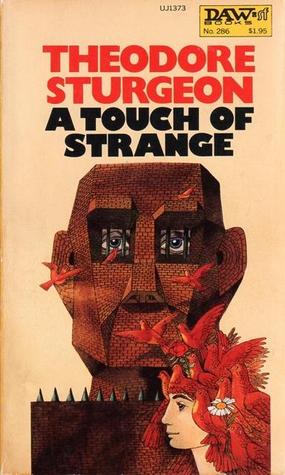 |
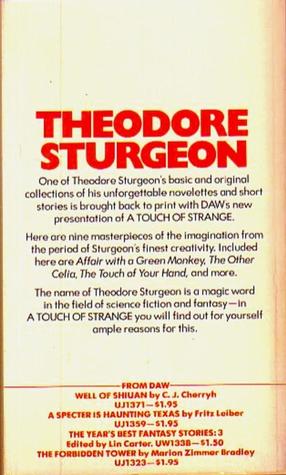 |
 |
In 1978, Sturgeon switched publishers, and a new edition of A Touch of Strange appeared from DAW, with a frankly hideous piece of what looks like stock art by Hans Arnold on the cover (above left). Far more interesting, I think, was the back cover text (above middle; click to get a bigger version). We’re no longer talking about “outer galaxies” and the “strange byways” of space to sell books… now, we’re just telling you how lucky you are to have these early “masterpieces of the imagination” by Theodore Sturgeon back in print. We’re not just trading on a little Sturgeon’s name any more…. Sturgeon is the story, full stop.
The 1978 DAW edition was the last time A Touch of Strange was returned to print in the US. It did have a UK edition later that year from Hamlyn Paperbacks, with a fine cover by Tim White (above right). Like the DAW edition, the Hamlyn included all nine stories.
Our previous coverage of Theodore Sturgeon includes:
A Touch of Strange (1958)
Not Without Sorcery (1961)
Sturgeon in Orbit (1964)
Starshine (1966)
Sturgeon is Alive and Well… (1971)
To Here and the Easel (1973)
The Stars Are the Styx (1979)
A Touch of Strange was published by Berkley Medallion in 1958, 1965, and 1970. The 1965 edition is 174 pages, priced at 50 cents. The cover is by Mike Trent. It has been out of print since 1978. There is no digital edition.
See all of our recent Vintage Treasures here.
I love that second Berkley cover. That’s the sort of image that always grabbed me when I was rummaging through old paperbacks at the thrift shop that was around the corner from my middle school. A cover like that WAS science fiction to me.
Agreed. Richard Powers had a (well deserved) reputation for almost single-handedly revolutionizing paperback covers in the 50s and 60s, introducing abstract art. But his 1958 cover for A TOUCH OF STRANGE I find rather flat.
Mike Trent’s cover for the 1965 edition, for all that it clearly owes to Powers, is far more colorful and evocative of the mystery of space exploration to me. It’s a splendid piece of work.
Thanks for the post, John. The 1965 edition is the only one I’ve seen. (I have it somewhere.) It’s nice to see the other editions. The 1970 edition’s art looks a little like Vincent di Fate.
I especially like the Hamlyn edition’s cover. If you look closely you can see what appears to be a reflection of a (shell? small animal skulls?) necklace in the water, but she’s not wearing a necklace.
> If you look closely you can see what appears to be a reflection of a (shell?
> small animal skulls?) necklace in the water, but she’s not wearing a necklace.
Sharp eyes, Keith. Looking at the cover, I can’t tell if those shells are meant to be a reflection, or something swimming in the water in front of her. Either way, it’s odd and a little fantastical.
Not a reflection or necklace. It is the pattern on the fabric of the clothing she is wearing, perhaps batik fabric shells pattern.